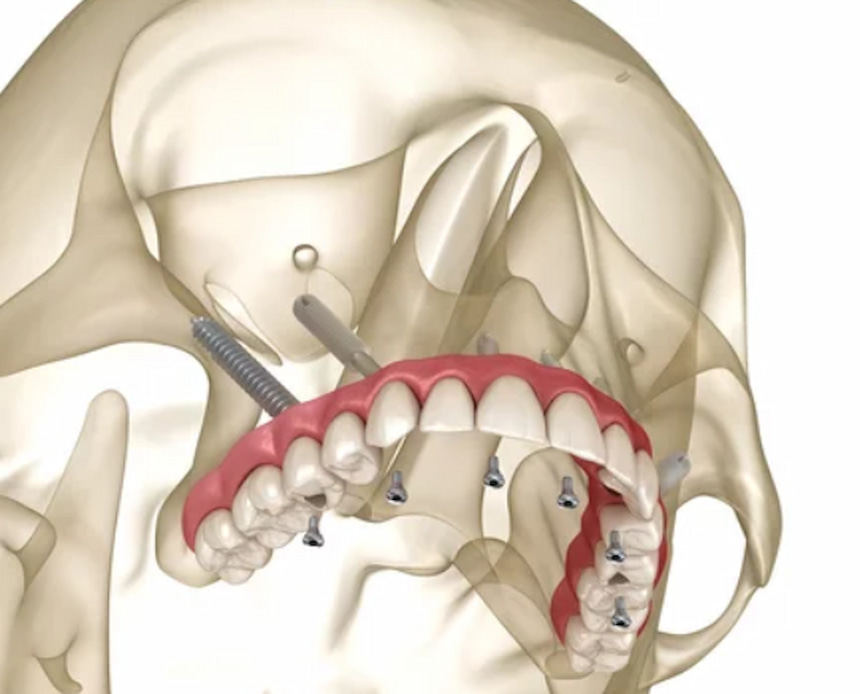
Choosing how to handle your deteriorating teeth and jaw health isn’t very easy. There is a lot to take into account. The differences between your options may be confusing as well, which is why we are going to break down two major options for you: bone grafts and zygomatic implants.
While zygomatic dental implants focus on just moving to a more supportive place for an implant, a bone graft helps to repair your jaw and get it ready for a more traditional implant. There are pros and cons to both, including recovery time, cost, and even face shape.
Keep reading to learn about the differences between these two surgical procedures.
What Is a Zygomatic Implant?
A zygomatic implant is a type of implant that moves away from the traditional methods for teeth. They focus on drilling into the cheekbones instead of the upper jaw. Since it is bypassing the jaw, where bone density may be low, there is no need for a bone graft on top of the implant surgery.
There also isn’t any need for additional surgery, like a sinus lift.

Procedure
With zygomatic implants, no additional surgery is needed. You will be put under, and then your implants will be drilled right into your cheekbones. This only takes one surgery, and any teeth that need to be extracted can be done at the same time this way.
Cost
Generally, per tooth, the cost is anywhere between $3,000 and $5,000. Some states are lower and some are higher, so it is always good to ask your doctor before proceeding.
Pros
- Fewer implant and prosthetic failures
- Easier to handle side effects
- No grafting procedures
- Treatment time is quicker
- No hospital admission
- Can last well over 12 years
- Higher rates of success
- Lower cost
- Immediate rehabilitation
- Shorter overall time between surgeries, check-ups, and appointments
Cons
- Inability to eat hard foods for two weeks or more
- Swelling
- Pain
- Antibiotics
- Sinusitis
- Nasal bleeding
- Doesn’t account for jaw health
- May notice face shape change over time due to deteriorating jaw

What Is a Bone Graft?
When people need dental implants, it is usually done by using the upper bone of the jaw. However, when that bone isn’t strong enough to hold up the implants, other methods have to be looked at, like the zygomatic implants discussed above.
Bone grafts are a much more traditional way of providing dental implants to those without the proper bone density. It also helps to reduce the loss of bone density that is occurring in the area.
Usually, people who don’t go to the dentist quickly enough after a tooth has been missing will show signs of lowered bone density. Other habits, such as smoking, can cause lower bone density as well.

Procedure
There are two main types of bone grafting known as autografts and allografts. Depending on several factors, either one of these can be used. Usually, a graft is performed to help hold implants in place.
Besides these two, there are xenografts, which use bones from another animal like a cow or pig, and occasionally coral. There are also alloplasts, which use synthetic materials in place of bone.
Autograft
Autograft is where the bone tissue from somewhere on the patient’s own body is harvested and reused in the area of the teeth. This is a good option as that means that the body won’t reject the tissue.
However, if there is a large area that needs to be grafted, this can cause problems because it isn’t safe to pull that much tissue from one place.
There is also the problem of now the patient having two surgeries performed on them, and a higher risk of infection and more time for recovery.
These grafts usually have around a 66% success rate and a 99% survival rate.
Allograft
With allografts, the bone tissue is gathered from a donor and stored in a tissue bank. This is often used for major grafts throughout the body, but can occasionally be used for teeth as well.
There is a reduced risk of infection, as only one dental surgical procedure is needed, instead of two or more. There is also a low risk of implant rejection as living cells aren’t present in the tissue.
These are not commonly used for teeth, however, as there is a limited amount of stored tissue, and many people aren’t comfortable with the idea of using tissue from someone deceased.
These usually have an 83% success rate and a 90% survival rate.
Cost
Since there are so many options out there, it isn’t easy to nail down a price. However, you can expect that for xenografts, allographs, and alloplasts, the cost is usually anywhere between $400 and $1200.
For autografts, you can expect at least $2000.
This may not seem like much, but remember, these are just the grafts. After that, you still have the cost of the implant itself, and any other surgeries that may still be required.
Pros
- Long-term solution
- Prevents any further bone loss
- Keep shape of the face
Cons
- Can raise prices quickly
- Are an additional cost on top of the actual implant
- More surgeries
- Higher recovery time
- Minimum of two surgeries, but more are possible
- May still have to get a sinus lift

Comparison Table
| Autograft | Allograft | Zygomatic Implant |
Success Rate | 66% | 83% | 98% |
Survival Rate | 99% | 90% | 96% |
Cost | Upwards of $2000 Plus implant costs ($1000 to $3000 per tooth) | $400-$1200 Plus implant costs ($1000 to $3000 per tooth) | $3000 to $5000 per tooth |
Number of surgeries | At least 3 | At least 2 | 1 |
Stability | 3-5 years | 6 months to 1 year | Upwards of 12 years |
Pain levels | Very high Prescription pain meds | High Prescription pain meds | Medium to low Over-the-counter pain meds |
Recovery time | Several weeks Plus implant recovery | A couple of weeks Plus implant recovery | A couple of weeks |
Side effects | ● Blood clots ● Nerve damage ● Rejection of graft ● Infection | ● Blood clots ● Nerve damage ● Rejection of graft ● Infection | ● Infection ● Rejection of graft ● Nose bleeds |
Can I Get Both a Zygomatic Implant and a Bone Graft?
Yes, it is possible to get both. If you want to keep your jaw shape, but don’t want to drill in that area for your implants, getting both is possible.
They cannot be done at the same time, but there is no harm in doing both throughout your lifetime to retain your jaw’s density and to get a dental implant you can be happy with.
However, it isn’t a very common practice. Most of the time, people get zygomatic implants so that they can avoid bone grafts. To get both is fairly costly and takes a lot of healing time that people cannot usually afford.
Conclusion
There are a few different options when it comes to fixing your teeth. If you don’t mind your jaw health, or the bone isn’t deteriorating at a fast rate, the zygomatic implant can be cheaper, faster, and requires fewer surgeries.
However, it doesn’t account for your jaw at all. If your jawbone is deteriorating, and you don’t want to worry about the health implications of that or the shape of your face changing, a bone graft is a good option. It is more costly and requires additional dental surgeries, but it does help prevent further deterioration of your jaw, and allows you to get more traditional implants.
Sometimes, the weight of the teeth and implant can help prevent any additional deterioration, such as with the zygomatic implants, but it isn’t a sure thing.
Now that you know more about these surgeries, you should feel more confident to make any decisions.

